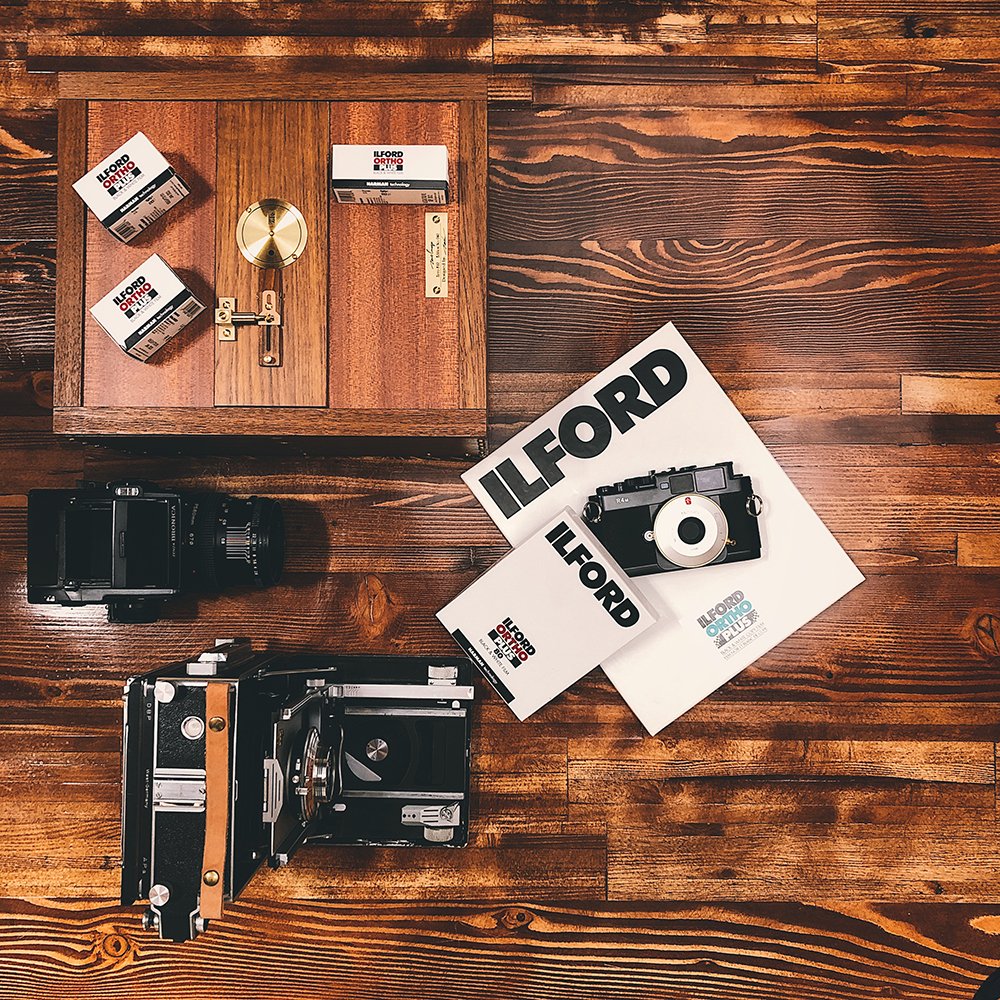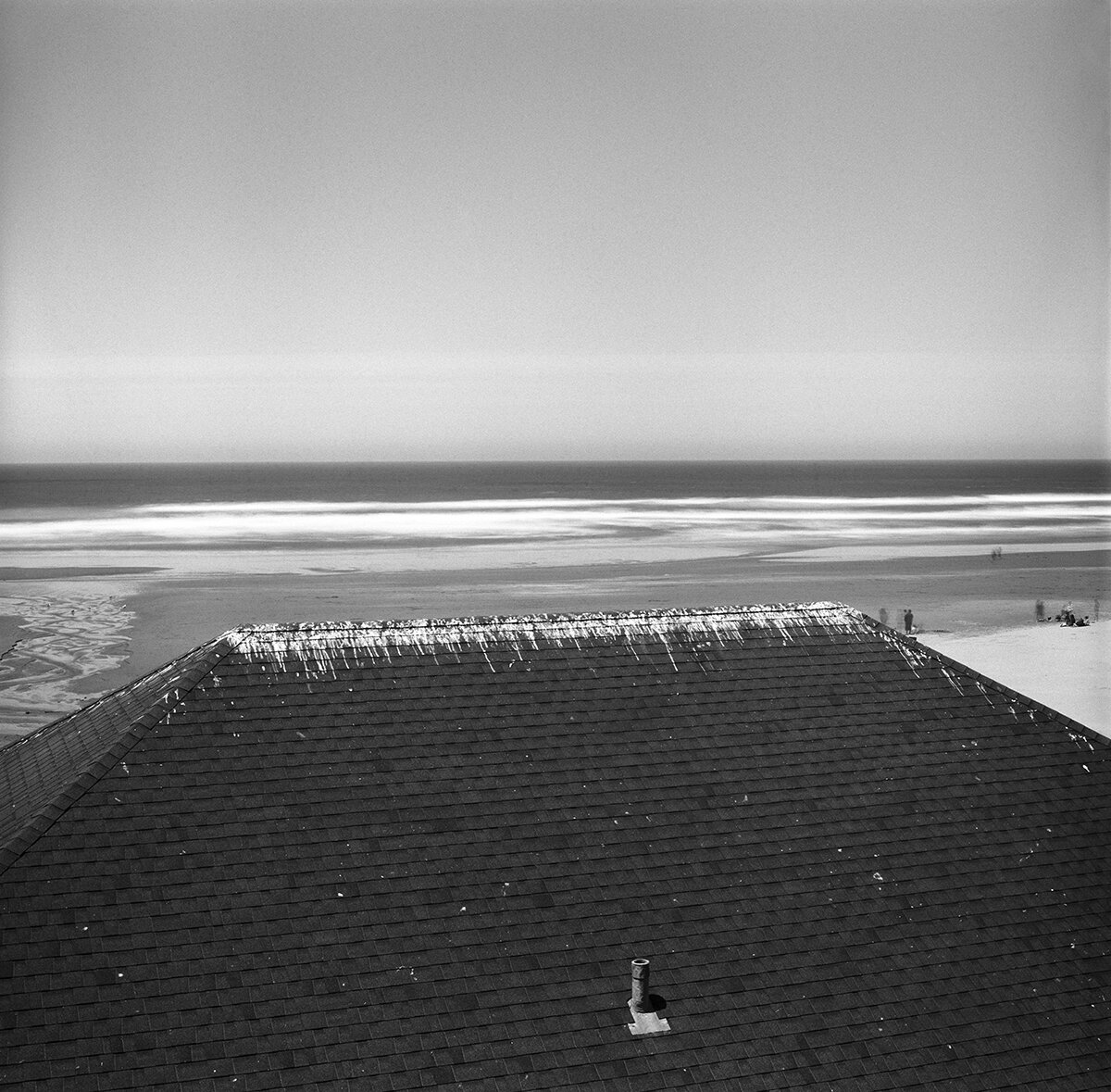Film Friday - June 6th, 2025. Ilford Ortho Plus Film Review
Ilford got film photographer’s attention when they teased the release of a new film in October of 2019. Speculation was rampant about what the new film would be. Well, it turned out to be an expansion of Ilford’s Ortho Plus film - which had previously been available in large format - into the 120 and 35mm formats. Ortho Plus is an emulsion that has been made available for years by Ilford, but being limited to large format sheets has kept this film largely under the radar of most photographers. Now that Ortho Plus is available in these smaller formats, even more of us have a chance to try this film out.
When testing a new film, what better place to start than with the St. Johns Bridge. Image made with a Hasselblad 500C.
Perhaps the best place to start is with “what is an ortho film?”. Ortho is short for orthochromatic. Most black and white films are panchromatic, meaning they can see all the colors of the visible spectrum and reproduce them as shades of gray. Generally speaking, panchromatic films are equally sensitive to all of the visible spectrum but not always. For example, some films may reproduce reds as slightly lighter grays than they would blues, but for the most part panchromatic films see the visible spectrum from violet to red equally. Orthochromatic films on the other hand can only see the blue and green end of the visible spectrum. This means two things. The first is that they will expose blue and green objects lighter than other colors, while underexposing oranges and reds into darker tones. So blue sky comes out much lighter in ortho film while white skin tones darken up. One potentially great use of ortho film is portraiture of someone with freckles, as the freckles will expose very dark and really stand out on their face. You may have noticed this with wet plate portraiture that you have already seen. It is a similar effect because wet plate collodion is an orthochromatic process. The other difference that this altered sensitivity makes is that ortho film tends to be higher contrast because it has a more compact selection of the spectrum with which to work.
The unique tonality of ortho film can produce stunning results, such as separating flowers from green leaves. Image made with a Canon (New) F-1.
One quick side note on ortho film’s sensitivity being limited to the blue/green end of the spectrum is that it can be handled under deep red safelights in the darkroom. You can develop your ortho by inspection this way. Before you potentially fog an entire roll though, make sure to do tests on a small batch of ortho film to insure that your safelight really is safe. Also, keep some distance between the developing film and those safelights and try to minimize the amount of time that the film is exposed to the red light.
Finally, the other key aspect of most ortho films is that they tend to be very slow and therefore extremely fine grained. Ilford’s Ortho Plus is an ISO 80 film, which actually makes it faster than other ortho films that commonly have speeds of ISO 25 or lower. But even at ISO 80, Ilford Ortho Plus is still superbly fine grained. If you like to make big darkroom enlargements that have as little grain as possible, this is the film for you. Just be forewarned, if you are used to focusing your images with a grain magnifier you might have to use a different means of insuring focus as sometimes you cannot see the grain of the enlargement even through the magnifier!
When testing a new film with human subjects, it never hurts to grab your favorite co-worker who loves to ham it up in front of a camera. Note the slight darkening of skin tones. If the subject has freckles, these will dramatically pop in the final image. Also blue eyes tend to get noticeably lighter.
A magnified crop of the above image to give you a sense of the grain you are dealing with in Ortho Plus. Perhaps grainier than some other ortho films, Ilford Ortho Plus is still extremely fine grained and very smooth in its appearance.
So why should you try a roll of Ilford Ortho Plus?
The main reason is because of that orthochromatic sensitivity. Perhaps you have already given infrared film a try, or at least some thought. The appeal of ortho film is quite similar to that of infrared. Ortho film has a very different way of seeing the world than our eyes, and experimenting with it can show you things you otherwise are not capable of seeing in the same fashion.
But the other fun aspect to ortho film is its ability to add a lot of drama to its images with its naturally higher levels of contrast. Take a roll of ortho film into dramatic lighting, such as storm light or golden hour and you have all the ingredients for making photographs that will have a lot of impact. It doesn’t have to be just about drama though. Ortho film, with its contrast, can make a nice film for really soft light as well when you don’t want the images to be quite as flat. In fact, ortho film historically was used as a copy film quite often because its contrast tended to reproduce images and negatives better in terms of tonality than other films which tended to produce flatter results.
This image was not actually made with Ilford Ortho Plus, but rather an earlier, now-defunct, ortho film. We are including it because it shows the possibilities that orthochromatic films have when photographing in dramatic lighting. Image made with a Pentax 6x7.
So try a roll of ortho film out on a foggy day, or in soft, low light. Shoot it in medium format and make images that have very little discernible grain. See how the world looks when greens are rendered more sensitively and reds are ignored.
In summary, then:
Very fine grain. Perfect for smooth enlargements.
Orthochromatically sensitive. Greens and blues render lighter, yellows, oranges and reds will be darker.
It’s slow speed is great if you are fond of long exposures.
Coated on a polyester base which is incredibly durable and the film should have excellent archival properties in good storage.
Available in a variety of formats including 35mm, 120 and large format.
Before we leave you with the last of our sample images from our first couple rolls of Ilford Ortho Plus, here is a quick link to the film on our website. As always, if you happen to be reading this on the day of the feature, the film will be discounted in our shop and on our site by 15%. Make sure to follow us on Facebook or Instagram to see which film is the spotlight every Film Friday!
We have almost every film stock available on the market. Check it out!
If you need an excellent lab for meticulous film developing, topnotch optical prints, traditional darkroom printing and superb film scanning, we’re your lab!
Also, sign up for our weekly newsletter The Loupe and keep your eyes peeled on our social media feeds every Friday when we feature a different film and also offer it at a one day discount of 15% off!
Ilford Ortho Plus shot well into dusk. Note the overexposure of the blue sky. Image made with a Hasselblad 500C.
The stark contrast of Ilford Ortho Plus is perfect for the gory details of Halloween leftovers. Image made with a Hasselblad 500C.
The St. Johns Bridge. Image made with a Hasselblad 500C.
Ortho film delivering a nice “pop” to this image of Horsetail Falls. Note that lush, green vegetation will lighten up under ortho film’s sensitivity. Image made with a Hasselblad 500C.
Make use of the naturally slower speeds of ortho film to more easily get long exposures even on brighter days. Image made with a Hasselblad 500C.
A charred tree is a reminder of the effects of the Eagle Creek Fire of 2017. Image made with a Hasselblad 500C.
When photographing during twilight with Ortho film, its sensitivity to blue can cause skies to overexpose, giving dusk a brighter, almost daytime, look. Image made with a Hasselblad 500C/M.
As with all films, the choice of developer can have a dramatic effect on the final look. This roll of Ortho was developed in a Pyro developer rendering incredibly smooth tonality. Image courtesy of Paul Barden.
The fine grain of ortho film can make 35mm look pretty spectacular. Image made with a Canon (New) F-1.





















